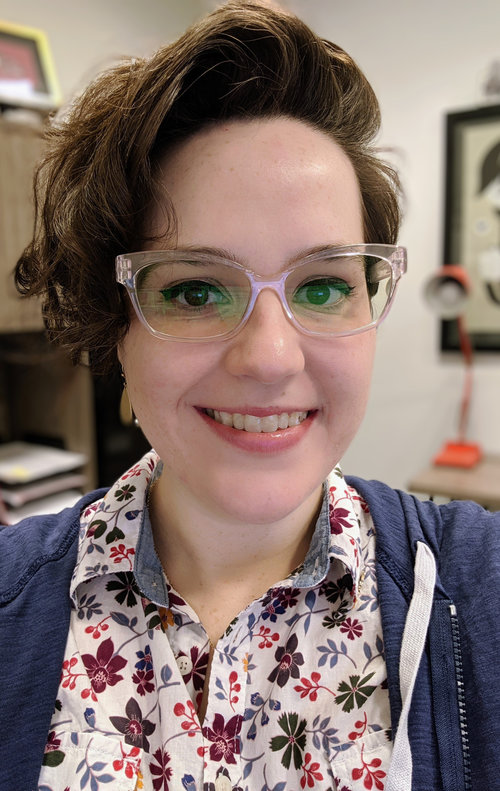By: Erin Adelman
We have all likely experienced the feeling to some extent: your life is moving at a pace out of sync with your peers, you are behind, you might not reach the next milestone that is expected of you.
Kate Rowekamp—a Cincinnati printmaker, illustrator, and animator—uses her art to think about the sociocultural expectations we face at different points in our lives.
“Something that I think about a lot is this abstract timeline that is used to determine how much success we have achieved in our personal lives,” she said. “In our culture, I feel it is a pretty common expectation that by the time you have reached a certain age you should have found a significant other, married, bought a house, had children, etc.”
Rowekamp’s dimensional drawings of whimsical “and occasionally eerie” creatures were displayed and sold at the silent art auction at Miami University’s 29th Annual Writers Harvest, a benefit event for Oxford Community Choice Pantry. The event also included a raffle and reading from local creative writers.
Rowekamp said her artwork provides a space in which she can grapple with emotions and comfortably share them with others. When writing an artist statement for a show, she said she conveys the general idea behind her artwork, rather than writing a specific explanation for each piece. Despite this intentional ambiguity, she said people still understand her message.
“The most surreal experience for me is when someone I’ve never met comes up to me at a show and shares their story of how they relate to the work,” she said. “…It always blows my mind to have conversations with complete strangers where they point to specific pieces and describe what it means to them and without knowing, absolutely nail what I was thinking when I made it. It is one of the things I love about being an artist, connecting and sharing with people who experience the same worries and frustrations I do, in a way that is somehow more articulate than putting it into words.”
Apart from her own experiences and emotions, Rowekamp said she draws inspiration from her interest in natural science, researching and illustrating plants and animals as part of her work. She said she is also interested in the visual aesthetic of graphic novels, video games, cartoons, and tabletop games, which are all visible influences in her artwork.
Rowekamp’s experiences as an undergraduate student at Thomas More College and graduate student at Miami University had a great impact on her artist style. During her undergraduate career, she apprenticed for Casey Riordan Millard, a Cincinnati-based artist whom she considers her greatest contemporary influence.
“But even before I knew her personally, I was a huge fan of how she used whimsical illustrations to confront deep emotional conflicts and her interdisciplinary approach to creating work,” she said of Riordan Millard.
Prior to her apprenticeship, Rowekamp said she thought artists had to pick and stick with one medium. She said Riordan Millard opened her eyes to combining multiple approaches in order to create an immersive environment for the viewer.
Another major influence on Rowekamp’s style is Edward Gorey, whom she said she discovered at a time when she was developing her personal style as a student. When she saw his surreal, dark ink illustrations, she said she knew they were doing the kind of things she wanted to do.
In graduate school, she said she learned more about incorporating technology into her creative process, which shaped her style and process today. She experimented with computer animation. This required drawing characters onto segmented paper that was scanned, assembled, and animated digitally. Though the puppet parts were originally intended to facilitate the animation development, Rowekamp said she enjoyed cutting and assembling the parts and applying fasteners so they could be displayed.
With limited access to tools and technology after graduation, Rowekamp adapted to using a scroll saw to create similar work.
Her current process still begins with a simple, unshaded drawing. Then, she transfers the drawing onto colored paper, adheres the paper to a wood sheet, and inks the outline. Using the scroll saw, she cuts the wood to the shape of the drawing. Lastly, she applies additional colors with ink, watercolor, and gouache.
Rowekamp advises young artists and art students to always be creating something. When she finished graduate school and began teaching, she said she made this her personal rule.
“Even if you only have a little bit of time here and there, it is important to keep your skills sharp and to have that creative outlet. Plus, you never know, you might hit on something that sparks a completely new body of work.”
She also encourages students to seek out every possible creative opportunity and diligently look for ways to make connections.
“A lot of people are scared away from pursuing a degree in the arts thinking there are no employment opportunities out there—which is absolutely not true!” Rowekamp said. “The trick is you just have to work hard, constantly apply for things, and (if you’re anything like me) try not to let your nerves get the better of you in the process. Rather than looking at job postings and thinking you have no chance, let the person in charge of hiring make that decision.”


